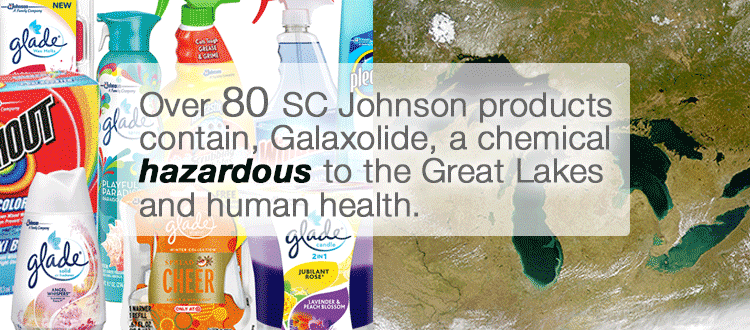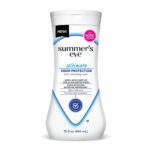Open Letter to SC Johnson from Leading Scientists Asking Company to Remove Toxic Galaxolide
In this open letter to SC Johnson & Son (SCJ), top scientists join us to express their concerns about the environmental impacts of Galaxolide, a chemical that is ending up in the environment and in you. This chemical is getting into your home, body and the environment as a result of its use in products. SCJ uses Galaxolide in over 80 products, from Scrubbing Bubbles to Glade air fresheners.
SCJ is basing their safety assessment on unpublished studies provided to them by the Research Institute for Fragrance Materials (RIFM), the research arm of the fragrance industry’s trade association. It’s a big problem when companies rely on unpublished, secret, industry-generated data to make a determination about a chemical’s safety.
The story of Galaxolide illustrates just how important it is for companies to tell the public how they test products for safety. After all, if a chemical as bad as Galaxolide can be deemed safe, what does that say about SCJ’s commitment to “people, the planet and generations to come”?
For more information, check out these Key Questions on Galaxolide and SC Johnson.
October 3, 2016
H Fisk Johnson, PhD
Chairman/CEO
SC Johnson & Son
1525 Howe Street
Racine, WI 53403-5011
Dear Dr. Johnson,
As scientists and health professionals we are writing to you with our concerns about your company’s continued use of the synthetic musk Galaxolide in your fragranced products. Galaxolide is a persistent, bioaccumulative, toxic chemical which is now found ubiquitously throughout our environment. Environmental monitoring from water samples from rivers and lakes, in tissue samples from fish and other wildlife, to blood and breast milk samples in humans, have all found Galaxolide in the vast majority of samples tested. This widespread contamination is a result of Galaxolide use in household products.[1] Due to the persistence of this chemical, its presence in our environment will continue to accumulate overtime from continued use and lack of degradation. We urge you to consider your company’s contribution to this environmental contamination and commit to phasing out the use of Galaxolide in your products.
Our concerns with SC Johnson’s use of Galaxolide are as follows:
1) Galaxolide rates as a Benchmark 1 chemical by a GreenScreen for Safer Chemicals Assessment
Women’s Voices for the Earth recently commissioned a GreenScreen for Safer Chemicals Assessment of HHCB and found that it was assigned a score of Benchmark 1.[2] Chemicals assigned the score of Benchmark 1 are those of highest concern and whose use is recommended to be avoided. Specifically, the GreenScreen® assigned the Benchmark 1 score due to Galaxolide’s high persistent, bioaccumulative and aquatic toxicity properties. The GreenScreen® also noted a moderate human health hazard for endocrine disruption, as well as a data gap for inadequate information on reproductive toxicity.
2) Galaxolide pollution is ubiquitous.
Galaxolide is a synthetic fragrance chemical widely used in consumer products. As a result, Galaxolide is detected in our environment nearly everywhere testing has been conducted. For example, a 2015 study of the effluent and sludge of 40 wastewater treatment plants across the United States detected Galaxolide in 100% of samples taken.[3] In another study, 81% of water samples from urban tributaries to the Great Lakes contained Galaxolide.[4] 100% of drinking water samples from a water treatment plant contained Galaxolide.[5] Not surprisingly given the persistent quality of Galaxolide, the chemical contamination of water inevitably leads to contamination of animals and humans. 96% of fish tissue samples contained Galaxolide in a study of fish living downstream from wastewater treatment plants.[6]
Another study detected Galaxolide in 83% of Atlantic salmon sampled.[7] 91% of humans tested in one study had Galaxolide in their blood.(Hutter 2009) 100% of humans tested were found to have Galaxolide in their fat tissue.[8] 97% of breast milk samples tested contained Galaxolide.[9] The ubiquity of Galaxolide in our environment is a clear sign of both its frequent use in everyday products and its persistent nature.
3) Galaxolide is not an essential ingredient in any product.
Galaxolide is a fragrance ingredient, imparting a component of the scent in a product. Many major household product manufacturers, such as RB (makers of Airwick), Clorox, and Johnson & Johnson have eliminated the use of Galaxolide from their products. These companies demonstrate that it is possible to manufacture popular fragranced products without Galaxolide. Indeed, in reviewing SC Johnson’s website we found that even your signature Clean Linen scent includes Galaxolide in some product types but not others. (For example, Clean Linen Glade Room Spray contains Galaxolide, whereas Clean Linen Scented Plug-Ins do not.)
4) SC Johnson is a major producer of consumer products containing Galaxolide in the United States
According to the US EPA’s Chemical Data Reporting tool, SC Johnson is one of just six companies reporting the use of Galaxolide in products in the United States (at a level of over 25,000 lbs per year.)[10] Despite being an industry leader in transparency of ingredient information, the amount of Galaxolide reported by SC Johnson was deemed confidential business information by the company, and is not publicly available. Thus we cannot compare SC Johnson’s Galaxolide use to the other three companies that did publicly disclose their reported Galaxolide usage in pounds per year. However, using SC Johnson’s exceptional product-specific ingredient disclosure website, we were able to identify over 80 SC Johnson products which currently contain Galaxolide, which indicate that it is still widely used within the company’s portfolio of products.[11]
Concerns about SC Johnson’s safety assessment
We understand that SC Johnson’s safety assessment team has previously investigated the safety of Galaxolide. Specifically, Galaxolide was prioritized by SC Johnson for further investigation as a result of an EPA PBT Profiler pilot study that found that Galaxolide exceeds EPA’s criteria for persistence, bioaccumulation and toxicity (PBT). According to a description of the pilot study, SC Johnson requested additional data on Galaxolide from the Research Institute for Fragrance Materials (RIFM). Apparently, RIFM provided SC Johnson with data which contradicted the results of the PBT Profiler, which led SC Johnson to conclude that Galaxolide was not a PBT.[12]
We are concerned that this conclusion was based on the same unpublished industry data that was used in both the recent European Union and EPA chemical assessments of Galaxolide.[13][14] Based on initial testing and modeling indicating that Galaxolide was a likely PBT, Galaxolide was prioritized for risk assessment review by both the European Union and United States regulatory authorities. However, both risk assessments came to the same surprising conclusion that Galaxolide was neither persistent nor bioaccumulative. Both assessments relied on the same handful of studies, which are largely unpublished and unavailable to scientists or advocates outside of the fragrance industry and which wholly contradicted the results of earlier testing and modeling. A list of the citations from these chemical assessments — which range from unpublished reports commissioned by the fragrance industry itself, to scientific posters presented at toxicology conferences by employees of Procter & Gamble — is enclosed with this letter. We are concerned that almost none of the research used to reverse the prior PBT designation of Galaxolide was ever peer-reviewed, nor is it publicly available. It is also of concern that the studies used to reverse the PBT designation were largely generated by institutions with a financial interest in establishing the safety of this chemical. On the contrary, the GreenScreen which was commissioned for Women’s Voices for the Earth also took into consideration several independent studies published in peer-reviewed journals which provided evidence of Galaxolide as both a highly persistent chemical and one that is highly likely to bioaccumulate.
The SC Johnson website states that the company is “committed to working every day to do what’s right for people, the planet and generations to come.”[15] We believe that eliminating the use of Galaxolide from products is consistent with the company’s stated commitment. The adverse effects of the continued use of Galaxolide will be experienced for generations to come. SC Johnson should take an important step now to change that future, and set an example for other manufacturers to follow. We urge you to consider your company’s contribution to this environmental contamination and commit to eliminating the unnecessary use of Galaxolide in your products.
Thank you for your consideration of these concerns. We would appreciate a response to this letter to be sent to Alexandra Scranton, Director of Science and Research at Women’s Voices for the Earth.
Sincerely,
Alexandra Scranton, MS
Director of Science and Research
Women’s Voices for the Earth
Note: Institutional affiliations listed for identification purposes only.
Ann Blake, PhD
Environmental and Public Health Consulting
Chris Brick, PhD
Clark Fork Coalition
Aly Cohen, MD, FACR
Founder & Medical Director, Integrative Rheumatology Associates, PC Faculty, Academy of Integrative Health & Medicine (AIHM) Fellowship Program Jones/Lovell Fellow, Arizona Center for Integrative Medicine
Barbara Erny, MD
Irene Erdelmeier, Ph.D.
Organic and Medicinal Green Chemistry Expert, Paris France
Elizabeth Friedman MD, MPH.
University of California, San Diego
Steven Gilbert, PhD, DABT
Executive Director, INND (Institute of Neurotoxicology & Neurological Disorders)
Lauren Heine, Ph.D.
Executive Director, Northwest Green Chemistry, Spokane, WA
Keri C. Hornbuckle, Ph.D.
University of Iowa, College of Engineering
Rainer Lohmann, Ph.D
University of Rhode Island, Graduate School of Oceanography
Anna Z. Pollack, PhD, MPH
Assistant Professor, Department of Global and Community Health
George Mason University
Dr. Lorena M. Rios Mendoza
Associate Professor of Chemistry, Department of Natural Sciences
University of Wisconsin-Superior
Sharima Rasanayagam PhD
Director of Science, Breast Cancer Fund
Ted Schettler, MD, MPH
Science Director, Science and Environmental Health Network
Anne Steinemann, PhD
Professor of Civil Engineering, The University of Melbourne, Australia
Domenica Tambasco, MD
Eric Uram
Headwater LLC, Madison WI
Vicki Watson, PhD
University of Montana, Division of Biological Sciences
Shawna Weaver, PhD
College of St. Scholastica, Duluth, MN
Dorothy Wigmore, MS
Occupational Health Clinical Center, Syracuse, NY
Click here to download a PDF copy of this letter.
—————————-
[1]Peck AM, Hornbuckle KC (2004) Synthetic musk fragrances in Lake Michigan. Environmental Science & Technology. Vol. 38(2):367-72. January 15, 2004.
[2]http://www.greenscreenchemicals.org/gs-assessments/chemical/1222-05-5
[3]Sun P, Casteel K, Dai H, Wehmeyer KR, Kiel B, and Federle T. (2014) Distributions of polycyclic musk fragrance in wastewater treatment plant (WWTP) effluents and sludges in the United States. Science of the Total Environment 493, pp.:1073-1078. 2014.
[4]Baldwin AK, Corsi SR, DeCicco LA, Lenaker PL, Lutz MA, Sullivan DJ and Richards KD. (2016) Organic contaminants in Great Lakes tributaries: Prevalence and potential aquatic toxicity. Science of the Total Environment. 554-555, 42-52. 2016.
[5]Wombacher WD and Hornbuckle KC. (2009) Synthetic Musk Fragrances in a Conventional Drinking Water Treatment Plant with Lime Softening. J Environ Eng (New York). 2009 November 1; 135(11): 1192
[6]Ramirez AJ, et.al. (2009) Occurrence of Pharmaceuticals and Personal Care Products in Fish: Results of a National Pilot Study in the United States. Environmental Toxicology and Chemistry. Vol. 28, No. 12, pp. 2587-2597. 2009.
[7]Kannan K, Reiner JL, Yun SH, Perotta EE, Tao L, Johnson-Restrepo B and Rodan BD. (2005) Polycyclic musk compounds in higher trophic level aquatic organisms and humans from the United States. Chemosphere 61, pp: 693–700. 2005.
[8]Kannan K, Reiner JL, Yun SH, Perotta EE, Tao L, Johnson-Restrepo B and Rodan BD. (2005) Polycyclic musk compounds in higher trophic level aquatic organisms and humans from the United States. Chemosphere 61, pp: 693–700. 2005.
[9]Reiner JL, Wong CM, Arcaro KF and Kannan K. (2007) Synthetic Musk Fragrances in Human Milk from the United States. Environmental Science and Technology. Vol. 41, No. 11, pp: 3815-3820. 2007
[10]https://www.epa.gov/chemical-data-reporting (Search conducted for CAS # 1222-05-5)
[11]https://womensvoices.org/safe-cleaning-products/sc-johnson-products-that-contain-toxic-galaxolide/
[12]Weeks JA, Martin FH, Tunkel J (2002) Case Study: SC Johnson’s Use of the EPA PBT Profiler to Screen SC Johnson’s Chemical Inventory, a Joint Study Conducted by SC Johnson and Syracuse Research Corporation. Available: https://www.epa.gov/sites/production/files/2015-05/documents/scjohnson-study-2002.pdf.
[13]US Environmental Protection Agency (2014) TSCA Work Plan Chemical Risk Assessment, HHCB, 1,3,4,6,7,8-Hexahydro-4,6,6,7,8,8-hexamethylcyclopenta-g-2-benzopyran CASRN: 1222-05-5. EPA Document# 746-R1-4001. August 2014.
[14]EC (European Commission). 2008. European Union Risk Assessment Report for 1,3,4,6,7,8-hexahydro-4,6,6,7,8,8-hexamethylcyclopenta-a-2-benzopyran (1,3,4,6,7,8-hexahydro-4,6,6,7,8,8-hexamethylin-deno[5,6-C] pyran-HHCB), CAS No. 1222-05-5, EINECS No. 214-916-9, Risk Assessment, Final Approved Version. Office for Official Publications of the European Communities, Luxembourg, The Netherlands.






